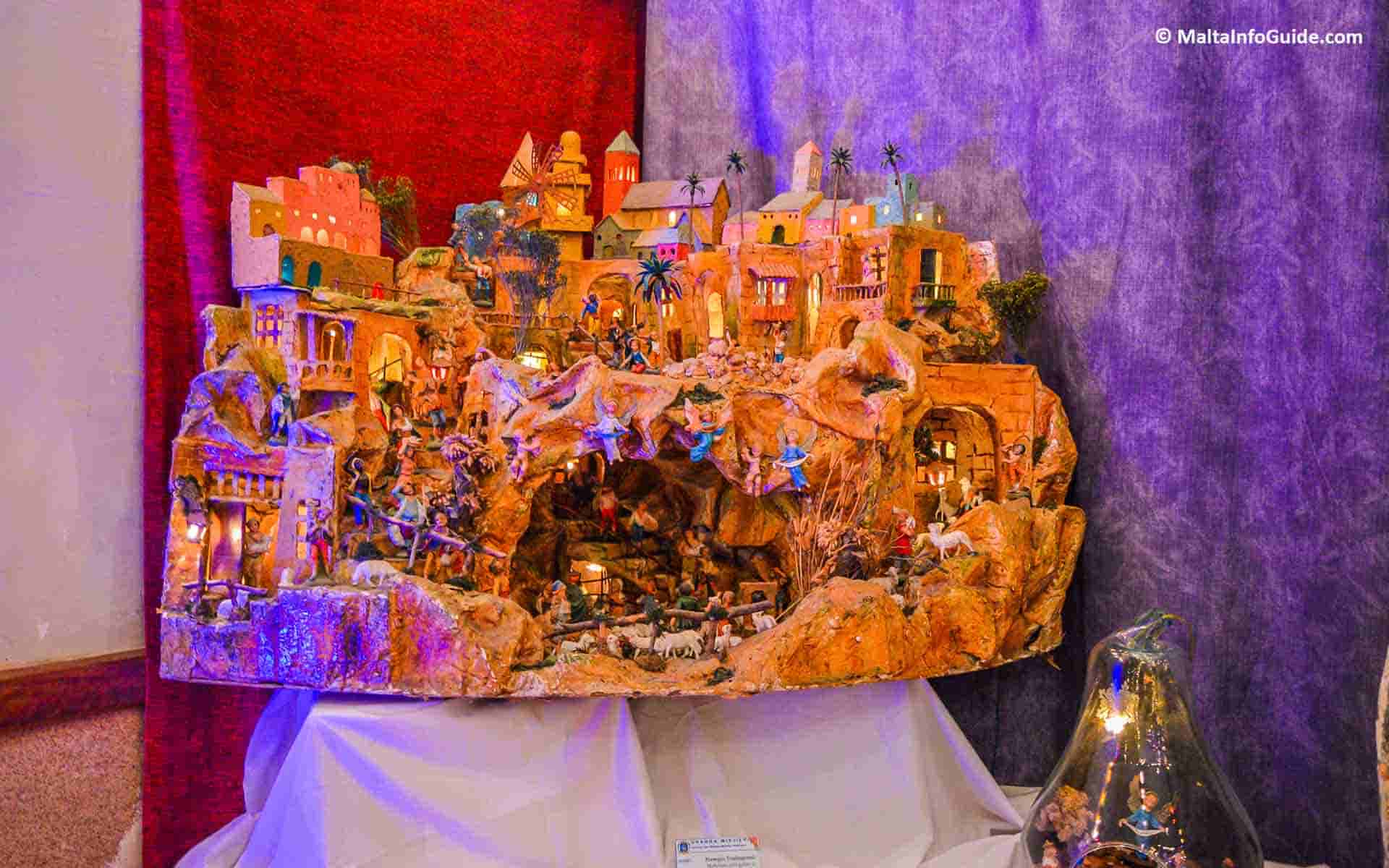- Home
- Malta Events Calendar 2025
- Christmas Crib
typical maltese Christmas Cribs
Different Types Of Cribs You Find On The Island
Christmas crib in Maltese is translated to 'presepju'. There is no Christmas in Malta without a crib. It is a staple part of traditions that has remained with us for very long.
You find them in every village and town exhibited behind glass doors or windows of houses It is laid in houses where it can be enjoyed by all family members.
Disclaimer — We may earn a commission if you book via certain links on the website. No extra cost to you.
📹 Top 7 Best Places To Visit in Malta For 2025
Wondering which spots in Malta should be on your 2025 travel list? Join us on a journey across Malta as we highlight breathtaking views, cultural gems, and experiences you won’t want to miss. Subscribe to our YouTube channel for more content like this. (Sound ON 🔊)
 Picture the large Christmas crib exhibited at the "Istitut Gesu Nazzarenu" institute Zejtun
Picture the large Christmas crib exhibited at the "Istitut Gesu Nazzarenu" institute ZejtunMechanical Crib In Malta
At the village of Zejtun there is a Christmas mechanical crib which is 65 years old. It has attracted many tourists and Maltese over the years.
It depicts the story of the nativity of the Lord including other scenes from the five Joyful Mysteries of the Holy Rosary.
The crib is located at the Institute and orphanage of Jesus of Nazareth in Bishop Emmanuel Galea Street, Zejtun in the south of Malta.
It was created by the late Bishop Emmanuel Galea who at the time was the director of this institute. He gave a home to hundreds of bereaved children.
How The Mechanical Crib Was Created
- Back to 1947 Bishop Emmanuel Galea had a wish to create a large crib recreating the nativity scene of the Jesus Christ.
- He himself did the works to create it and opened it for public viewing during the same Christmas up to where he had completed.
- He had asked for help from Paul Pavia of Zejtun to work on the mechanization of the crib figures. The Institute's nuns sewed all the clothes for each figure.
- The crib was completed after several years of works until it reached the present size.
Construction Of The Crib
- The materials used were newspaper and glue, whole wooden doors and various pieces of assorted wood.
- The mechanical section was entrusted to a Zejtun resident Paul Pavia who in such a clever way succeeded to operate all the figures of the crib.
- With just one motor, which was attached to a multitude of nylon strings. These were made to function by means of different sizes of pulleys, old bicycle chains which were very common at the time, and cinema film reels.
- All placed at various strategically positioned underneath the crib connected to the many figures exhibited in the crib.
- All movements were according to the representation of the figure. All this apart from creating the ingenious way to create the figurines movements made from wood and iron wire which was even more difficult so one had to be very creative due to lack of materials and funds.
Visits To The Christmas Mechanical Crib
The Christmas mechanical crib is open to the public.
- When: Mid-December until 4th January.
- Opening hours: 09:30 to 12:00 and 16:00 to 19:00 pm.
- Contact: +356 2167 4498.
- Address: Jesus of Nazareth Sisters, 51, Triq San Girgor, Zejtun, Malta.
my family cribs in the past
One of the traditions in Malta was the use of gargazza for crib building, known as slag, which was derived from burnt coal residue.
It was very abundant during the time when a lot of coal used to be used in bread bakeries, until more modern fuels used in furnaces, it was less abundant and so the supply became very scarce. Apart from this the use of stone was rather cumbersome.
When I was very young I remember going with my older brother to the furnace in our street where I used to live to bring the gargazza to our house and build the crib on one of the tables we had at our house.
The family who had this furnace, which was used for the production of bread, used to be very willing to give us their material and always encouraged us to build nice cribs.
 Christmas Nativity Crib exhibition at the village of Birkirkara
Christmas Nativity Crib exhibition at the village of Birkirkaratypes of crib construction
Paper-Mache: In recent years the trends have changed to paper-mâché. This material gives the Christmas crib the opportunity to keep it from one year to another and makes the crib more solid and lighter. Now-a-days other materials are used like jablo, wood and carton of various thicknesses to form bridges, houses and supports.
Glue Beads: The most common glue was glue beads which used to be put in an old pot, heated and then spread on the required areas with a stick and with the hands form the required shapes of the crib one piece at a time. One had to be careful not to burn his hand while doing this work. Then the completed work had to dry up.
Colouring: The colouring of the finished dry structure used to be painted with water colours. The most common ones were shades of brown mixed with yellow to indicate soil, stone buildings, rubble walls, timber doors and windows. Green for trees, and types of vegetation. Before the application a base of glue is applied and then the colours. In this way it will not drop out but remain fixed. Little by little the crib is painted keeping a consistence to get it matching all through.
 A large crib exhibit and a smaller one in a glass ornamental bottle
A large crib exhibit and a smaller one in a glass ornamental bottleClay statues pasturi in Maltese
The Christmas crib is then decorated with clay statues called pasturi in Maltese. A good designer of a crib will be capable to calculating the scale of the buildings to the size of the pasturi. The main figure of the crib is the Holy Family, namely Mary, Joseph and Jesus Christ and the nativity angel which will be in a way hanging around the grotto where Baby Jesus is lying in the manger.
Then the three Magi where in Malta there is the tradition to include these three figures on the 6th of January according to the bible story and church traditions. The feast of the Epiphany is celebrated on the 6th January.
 Christmas Nativity Crib during an exhibition in Valletta
Christmas Nativity Crib during an exhibition in VallettaDepending on the
size of the crib, many other figures are included, having included the proper
scenery and setting to include shepherds with their flocks of sheep. Other persons who form part within a village area are the baker, the woman who
carries the water from the well, the musicians, farmers ploughing the fields.
The cribs are embellished with all sorts of interesting decorations including the unmistakable growth of vetch known as gulbiena in Maltese. It is grown in flat pans some five weeks before Christmas and kept in the dark until it is fully grown. Many embellish the crib surround or the manger of Baby Jesus with all sorts of decoration like small bulbs and plants which reflect the Maltese culture and traditions styles.
The Christmas crib on our islands form part of the Christmas in Malta cultural heritage.
🏨 Find the Best Places to Stay Nearby
This fantastic interactive map below helps you discover the best accommodation across the island from a variety of trusted platforms. Explore different areas, compare prices, and book directly all in one place.
🚗 Need a car for your Trip to Malta?
Discovering the beauty of this gem in the Mediterranean by car is certainly the best way to experience its hidden beaches, charming villages, and also hidden paths that are difficult to reach by public transport.
Find The Best Rates On Your Car Rental Now!
 By Albert and Benjamin Magro
By Albert and Benjamin Magro






